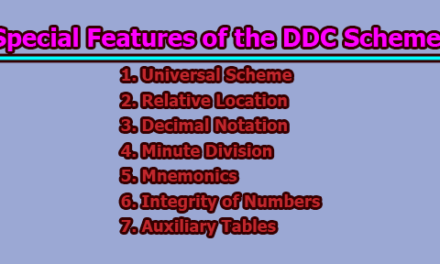Difference between Knowledge Classification and Book Classification:
Knowledge classification and book classification are two distinct approaches to organizing information, thoughts, and ideas. While both share the goal of creating order and facilitating access to information, they differ in their scope, methodology, and purpose. Let’s explore the difference between knowledge classification and book classification.
| Aspect | Knowledge Classification | Book Classification |
| Purpose | It arranges knowledge by evaluating and classifying thoughts, ideas, and concepts for a universal purpose. | It arranges the expression of knowledge, preserving it in written records and documents for specific purposes, such as facilitating access to information in a library or bookstore. |
| Scope | It adequately represents the field of human learning, encompassing a wide range of subjects and disciplines. | It provides an adequate subject approach to the existing collection of books, focusing on categorizing and organizing written works within the limited scope of a library or a specific collection. |
| Basis | It is based on preconceived ideas, essentially superficial, relying on human understanding and perception. | It is constructed by producing helpful arrangements based on the ‘order of nature,’ often following established classification systems such as the Dewey Decimal Classification or Library of Congress Classification. |
| Dimensionality | Knowledge classification is multi-dimensional, accommodating complex relationships and interconnectedness. | Book classification must be one-dimensional from left to right along the shelf, typically following a linear arrangement for ease of physical organization and access. |
| Reality vs. Expression | Reality cannot be classified; our knowledge exists as expressed thoughts, ideas, and interpretations. | Book classification is a convenient device for locating known works based on their physical manifestation, such as books, articles, or manuscripts. It deals with the expression of knowledge rather than its abstract form. |
| Pre-requisites | The terms, which are un-linear, must be set down before classification can be made, often requiring expert input and theoretical groundwork. | Book classification can be constructed as per the ‘order of nature’ of published works, using established systems that already define subject areas and their relationships. Expert input and theoretical groundwork might still be involved, but it is primarily focused on fitting works into the existing system. |
| Method | It is the mental planning of the thought (subject), requiring a deep understanding of the subject matter and its conceptual structure. | It is the transcribing of thoughts into subjects or categories based on the content and nature of the works themselves, aiming for efficient organization and retrieval. |
| Components | It consists of the main branch of the universe of knowledge, reflecting the fundamental divisions of human understanding. | It consists of terms of knowledge or subject headings, reflecting the specific topics and content covered by individual books or works. |
| Nature | It is a human mental faculty, shaped by culture, historical context, and individual perspectives. | It contains words and phrases used for human mental faculties, reflecting the language and vocabulary used to describe the content of books and works. |
| Heterogeneity | It is a homogeneous region of the universe of knowledge, grouping related ideas and concepts together. | It is the first array of schemes, and each term of the array makes a significant area of knowledge, ensuring that each book is appropriately categorized and accessible within the given system. |
| Adaptability | It is based on personal theories, and a new doctrine might upset the classification, requiring revisions or updates. | It is based on established systems, and new doctrines or ideas are accommodated through updates to the classification system, maintaining consistency and continuity. |
Finally, knowledge classification and book classification serve different purposes and operate on different levels. Knowledge classification deals with the abstract organization of human understanding and encompasses a wide scope of subjects and ideas. It is based on human perception and understanding, making it multi-dimensional and reliant on expert input. On the other hand, book classification is concerned with the physical arrangement and organization of written works, focusing on specific subject areas within a limited context, such as a library or bookstore. It follows established systems and aims for efficient retrieval and accessibility. Both approaches are essential for organizing and accessing information, with knowledge classification providing a deeper conceptual framework and book classification facilitating practical access to the knowledge expressed in written form.

Library Lecturer at Nurul Amin Degree College










